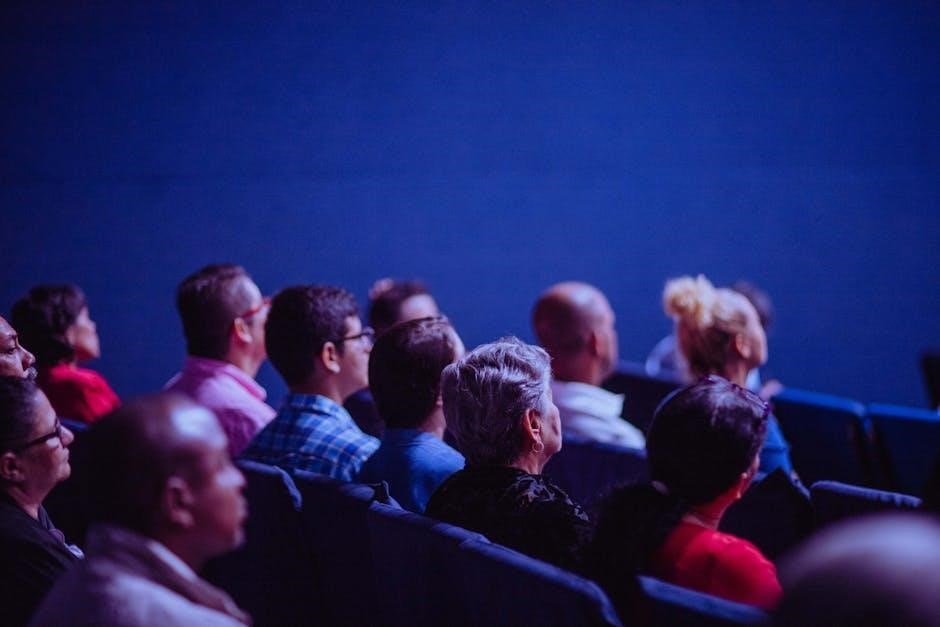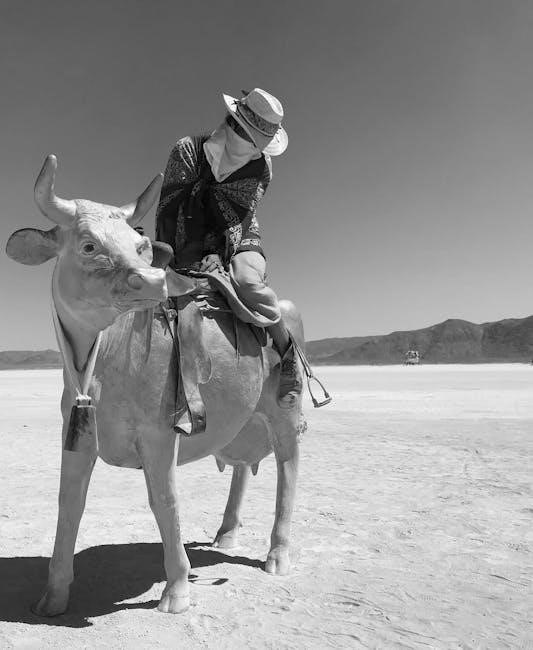Bandura’s Social Learning Theory: An Overview
Albert Bandura’s Social Learning Theory (SLT) posits that learning occurs through observation, imitation, and modeling. SLT provides a framework for understanding, predicting, and changing human behavior. It emphasizes social context in development.
Social Learning Theory, pioneered by Albert Bandura, offers a revolutionary perspective on human behavior. It moves beyond the idea that our actions are solely driven by internal forces or external conditioning. Instead, it highlights the significant role of observing others in shaping our behavior, attitudes, and emotional reactions. This theory suggests we learn through a process called vicarious learning, acquiring new knowledge and behaviors by watching others. Bandura’s work emphasizes the importance of norms and social context in understanding and predicting human behavior, laying the foundation for a more comprehensive view of psychology.
Key Concepts of Social Learning Theory
Key concepts include observational learning, where individuals learn by watching others. Modeling involves imitating observed behaviors. Vicarious reinforcement plays a role, as witnessing others being rewarded or punished affects behavior.
Observational Learning
Observational learning, a core component of Bandura’s Social Learning Theory, highlights that individuals can acquire new behaviors by observing others. This process, also known as vicarious learning, allows individuals to learn without directly experiencing the consequences of their actions. Influential models, such as parents, peers, and media figures, significantly impact this form of learning. By watching these models, individuals learn new actions and attitudes. This theory emphasizes the cognitive processes involved in learning, asserting that attention, retention, reproduction, and motivation are critical for effective observational learning. This approach provides a valuable framework for understanding how norms and context shape social behavior.
Vicarious Reinforcement
Vicarious reinforcement is a crucial aspect of Social Learning Theory where individuals are motivated to imitate behaviors they observe in others who are being rewarded. When someone witnesses another person receiving positive reinforcement for a specific action, they are more likely to replicate that behavior themselves; This type of learning hinges on the observer’s perception and interpretation of the model’s experience. It is not necessary for the observer to directly experience the reward; simply witnessing the positive outcome for the model increases the likelihood of imitation. This process enhances understanding of how observing others’ successes influences behavior adoption and modification.
Modeling
Modeling, a core tenet of Social Learning Theory, underscores how individuals learn by observing and replicating the behaviors of others. These “models” can be parents, peers, or even media figures, whose actions serve as a template for learning new skills and behaviors. The effectiveness of modeling depends on several factors, including the model’s characteristics, such as their perceived credibility and attractiveness, as well as the observer’s motivation and attention. Successful modeling leads to the acquisition of new behaviors, attitudes, and emotional reactions. Ultimately, modeling facilitates learning through imitation and observation, thereby shaping individual behavior and social norms within communities.
The Four Mediational Processes
Social Learning Theory highlights four mediational processes crucial in learning: attention, retention, reproduction, and motivation. These cognitive processes determine whether a learned behavior will be acquired and performed by an individual.
Attention
Attention is the initial step in observational learning, focusing on recognizing and attending to the model’s behavior. Several factors influence attention, including the model’s characteristics, such as attractiveness or authority, and the observer’s cognitive abilities and past experiences. Individuals are more likely to pay attention to models they find interesting, credible, or similar to themselves. The perceived relevance and value of the observed behavior also play a significant role in capturing and sustaining attention. This selective focus is crucial for successful learning through observation and imitation, setting the stage for the subsequent mediational processes.
Retention
Retention involves remembering the observed behavior, a crucial step in social learning. This process relies on cognitive strategies, including symbolic coding, mental images, and verbal descriptions, to represent and store the observed behavior in memory. Rehearsal, both mental and physical, further strengthens retention, enhancing the likelihood of recalling the behavior later. Factors like cognitive abilities, memory capacity, and the meaningfulness of the observed behavior influence retention effectiveness. Without successful retention, individuals cannot reproduce the behavior they have observed, highlighting its importance in the overall learning process within Social Learning Theory.
Reproduction
Reproduction translates mental representations of observed behavior into actual actions. It involves having the physical and cognitive capabilities to perform the behavior. Individuals must organize their responses according to the modeled behavior. Practice is crucial for improving motor skills and refining the reproduced behavior. Self-observation and feedback play a vital role in correcting discrepancies between the mental image and the actual performance. The availability of resources, guidance, and opportunities to practice significantly influences the success of reproduction. If an individual lacks the necessary skills or resources, reproducing the observed behavior may be challenging or impossible.
Motivation
Motivation is the driving force behind learning and performing observed behaviors. While an individual may pay attention, retain information, and possess the ability to reproduce a behavior, they may still not perform it without sufficient motivation. Reinforcement and punishment play a crucial role in motivating behavior. Vicarious reinforcement, observing others being rewarded for a behavior, can increase motivation. Conversely, vicarious punishment can decrease it. Intrinsic motivation, derived from personal satisfaction or a sense of accomplishment, can also be a powerful driver. External incentives, such as social approval or tangible rewards, can further enhance motivation to replicate observed actions.

Self-Efficacy in Social Learning Theory
Self-efficacy, a core component, refers to an individual’s belief in their capability to execute behaviors necessary to produce specific performance attainments. It significantly influences motivation, behavior, and the choices individuals make. High self-efficacy leads to greater effort, persistence, and resilience in the face of challenges. Individuals with strong self-efficacy are more likely to set ambitious goals and persevere in achieving them. Self-efficacy is developed through mastery experiences, vicarious experiences, social persuasion, and emotional and physiological states. Bandura emphasizes that self-efficacy is not a fixed trait but rather a dynamic belief that can be enhanced or diminished through various experiences.

Applications of Social Learning Theory
Social Learning Theory finds application in education by understanding how students learn through observation. It is also used in health promotion by modeling positive behaviors, and in sustainable natural resource management.
Education
In education, Social Learning Theory provides a framework for understanding how students learn through observing teachers and peers. Teachers can use modeling to demonstrate desired behaviors, attitudes, and emotional reactions. Observational learning and modeling are effective methods for students to learn new skills and knowledge. By observing and imitating, students can improve their understanding and performance. Teachers can foster positive learning environments by modeling appropriate behaviors and creating opportunities for students to observe and interact with positive role models. This enhances the effectiveness of learning via observational learning and contributes to a richer educational experience.
Health Promotion
Social Learning Theory plays a crucial role in health promotion by influencing behaviors through observation and modeling. Health campaigns can use SLT to promote healthier lifestyles. By observing positive role models adopting healthy behaviors, individuals are more likely to imitate those actions. Media figures and community leaders can effectively model desired health behaviors. This approach has been applied to encourage exercise, improve nutrition, and reduce risky behaviors such as smoking. Social learning theory can be used in Swaziland to mitigate HIV. Promoting health through observation and modelling is useful.
Sustainable Natural Resource Management
Social learning theory is increasingly recognized as a key component in sustainable natural resource management, promoting desirable environmental behaviors. By observing and modeling successful sustainable practices, communities can adopt more responsible resource use. This involves learning from others’ experiences and adapting their behaviors to protect the environment. Effective strategies include showcasing successful sustainable projects, providing opportunities for communities to interact and learn, and using social modeling to encourage responsible resource management. Social learning enhances cooperation and knowledge sharing, leading to improved conservation outcomes and long-term ecological benefits through community collaboration and shared environmental ethics.
Criticisms of Social Learning Theory
While influential, Social Learning Theory faces criticisms regarding its scope and emphasis. Some argue it doesn’t fully address the complexities of cognitive development, potentially oversimplifying internal thought processes. Critics suggest the theory may underemphasize individual differences in temperament, motivation, and innate abilities, focusing primarily on external influences. Additionally, the theory’s reliance on observation and modeling may not adequately account for instances of spontaneous, novel behaviors that arise without direct exposure. Concerns have also been raised about the potential for learned behaviors to be used for negative purposes, such as aggression or manipulation, without sufficient focus on ethical considerations and individual responsibility.

Social Learning Theory vs. Social Cognitive Theory
While rooted in Social Learning Theory (SLT), Social Cognitive Theory (SCT) represents an expansion and refinement by Albert Bandura. SLT primarily emphasizes observational learning and external environmental factors’ influence on behavior. SCT, however, integrates cognitive processes more explicitly, acknowledging reciprocal interactions between behavior, personal factors (cognition, emotion), and the environment. SCT highlights self-efficacy, the belief in one’s ability to succeed in specific situations, as a central component. Unlike SLT, SCT emphasizes self-regulation and personal agency. Essentially, SCT builds upon SLT by providing a more comprehensive understanding of human behavior through the inclusion of cognitive elements like beliefs and self-perception.
Real-Life Examples and Experiments
Bandura’s Bobo doll experiment vividly illustrates social learning. Children observing adults acting aggressively toward the doll were more likely to replicate similar behaviors. This highlights observational learning’s power. Media influence provides real-world relevance; exposure to violence can desensitize and increase aggression. Educational settings demonstrate modeling; students learn from teachers and peers. Health campaigns utilize modeling to promote healthy behaviors, showing individuals adopting desirable actions. Vicarious reinforcement plays a role; seeing others rewarded for certain behaviors encourages imitation. These examples demonstrate how social learning operates across various contexts, shaping attitudes, behaviors, and emotional reactions. Social learning is relevant to fight against HIV.

Resources for Further Learning
To delve deeper into Bandura’s Social Learning Theory, explore his seminal book, “Social Learning Theory,” published in 1977. Academic journals like “Organizational Behavior and Human Decision Processes” offer scholarly articles examining the theory’s applications. Online repositories such as eGyanKosh provide digital learning resources from open and distance learning institutions. ResearchGate hosts numerous research papers, including systematic reviews on the theory’s impact on sustainable natural resource management. University libraries and online databases offer access to peer-reviewed articles, case studies, and experimental findings. Look for publications referencing Bandura’s later work on Social Cognitive Theory for an evolved perspective. Consider exploring resources from institutions dedicated to open education.



